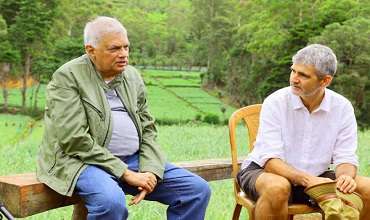FEATURE -Are we making rational decisions in the rice sector?
By M. P. Dhanapala, former Director, Rice Research and Development
Agrochemicals, inclusive of chemical fertilisers, are to be replaced by non-toxic organic manure and other environmental friendly products based on the expert advice that the modern agricultural products are toxic due to indiscriminate use of agrochemicals. An example frequently cited was the Chronic Kidney Disease (CKDu) of unknown origin in the North Central Province. Also, some critics insist that those who promote agrochemicals are rewarded by multinational companies involved in the agrochemical industry.
As a result, agrochemicals in agriculture was a topic debated in public media by policy makers, their advisors, specialist doctors, university professors, professionals of organic agriculture, scientists, politicians, leaders of farmer organizations etc. The above allegations were refuted as inaccurate, inconclusive and unscientific (Pethiyagoda, R. U-tube seminar https://www.youtube.com/watch?v=rGe6ld2q1vs). According to some scientists, the causal agent of CKDu was concluded as high concentration of Fluoride ion (Fl-) in drinking water. As a rice scientist, I have some issues bothering me in this whole dispute; especially in the area of chemical fertiliser, the most indispensable, one and only input, that increases productivity of crops.
Rice farming is the least remunerative of all occupations in Sri Lanka; the farmers in the past were involved in rice farming because of the social dignity, the pride of being not consuming imported rice (Beven, 1914, Tropical Agriculturist, 1914 Dec.). Also, farming is considered an independent profession; the fact that one has to pay respect when dealing with the farming community.
Organic manure issue
Some critics insist that we have lost the organic manure technology practised 3000 years ago; probably a documentation failure. It would be great if we could recover the old technology from somewhere. However, in the recent past, as documented in the scientific journal “Tropical Agriculturist”, incorporation of bulk organic matter was recommended as early as in 1914 for rice fields to circumvent disintegration and deterioration of soil structure due to puddling during land preparation (Harrison, 1914). The nutritional status of the organic material concerned was not quantified or discussed. This recommendation was made during the British era, around the inception of the Department of Agriculture, and it is valid even today.
In the 1940s, farmers did cultivate traditional varieties with green manure, farmyard manure, compost, soybean cake, fishmeal etc. as organic manure but no specific recommendations were recorded. The targeted rice yield then was 15 bushels per acre (0.75 t/ha.) but realized only a national average of less than 13 bushels/acre (< 0.65 t/ha). The government then had to import two thirds of the rice requirement of the country to feed the population (Tropical Agriculturist, 1945 July – Sept.). The rice ration book era continued till the modern varieties were developed and established. The present day advisors and policy makers may be unaware of or have ignored that the rice ration book each citizen had with 52 weekly stamps, to obtain the imported (milchard/white raw) rice ration from the nearby cooperative shop.
Incorporation of paddy straw into fields was emphasized just before the turn of the Century to sustain soil fertility and organic content of the soil, especially when the cropping intensity increased with the release of high potential short duration rice varieties. This recommendation was complemented with site specific soil test-based fertiliser recommendations, using the regional recommendations as guidelines, to prevent indiscriminate use of fertiliser. Also, the researchers were vigilant to keep the high organic soils with poor and impeded drainage (wet zone) devoid of organic manure while taking precautions to prevent straw/crop residue becoming a primary inoculum of diseases.
We have no doubt that the organic manure improves physical, chemical and biological properties of the soil. Organic manure has colloids, composed of protein rich material with negatively charged amino acids, and help to build up the soil structure and cation exchange capacity (CEC) thus improving the nutrient retention power of the soil. Organic manures are not known as rich sources of plant nutrients. The nutrient contents and efficiency of different sources of organic manure are shown in Table 1.
Table 1. Average nutrient content and efficiency of organic matter
___________________________________
Organic matter Nutrient (% dry weight) Efficiency index
source N P2O5 K2O N P2O5 K2O
___________________________________
Compost 0.8 0.4 0.5 40 100 80
Saw dust manure 0.4 1.0 1.0 40 100 80
Rice straw 0.6 0.2 2.2 -- -- --
Rice husk 0.4 0.2 0.5 -- -- --
Cattle manure 1.4 1.2 2.6 100 100 100
Pig manure 1.8 1.7 0.7 100 100 100
Poultry manure 3.0 5.0 2.4 100 100 100
Human waste 3.1 5.3 0.4 100 100 100
______________________________________________________________________
Extracted from JA handbook, Pages 80 and 175 (Japan Agriculture)
The nutrient content of organic manure from the above sources in Sri Lanka cannot be significantly different from values in Table 1, unless there had been some other additives incorporated in the process of manufacture.
Now, let us consider the nutrient recommendation for the most popular group of rice varieties (3.5 month) grown under irrigation in the dry-zone. The present recommendation per hectare is 105 kg Nitrogen (N), 25 kg Phosphorus (P2O5) and 35 kg of Potash (K2O) (Page 15, Fertiliser Recommendation for Rice, Department of Agriculture, 2013). As an example, we will examine the requirement of the most controversial nutrient component, nitrogen (N), in this recommendation. To meet this N requirement, the farmer should have around 13 tons of moisture free compost (0.8 percent N) for one hectare of land, assuming that the harvested straw of the previous season is not incorporated into the soil. If the compost available has 20 percent moisture, this figure would be little more than 16 tons. The farmer then will have to pay for and carry in the field a little more than 3 tons of water on his back for every hectare of rice land cultivated. Additionally, there are peak requirements of N at different growth stages of the crop to promote yield components of the plant. The compost, once applied, will release N consistently, irrespective of the peak requirements of the crop growth stages and may continue this process even beyond the life-span of the crop as long as the mineralization process continues. This example may be too much of an exaggeration, but the advisors/policy makers should know how inappropriate it is, to substitute a technology, more relevant for home gardening, for extensive paddy cultivation; this probably will be the reason behind the denial of compost culture by commercially oriented rice cultivators. Besides, it is unethical to force on the farmers, a new technology unfamiliar to them altogether. The organic farming specialists can demonstrate in large scale field trials their intended package of practices, specifically in different agro-ecological regions, to ascertain its appropriateness; feasibility, economic viability, sustainability and other advantages, to convince and gain farmer acceptance. The total package of the proposed organic rice farming may include other options; green manure crops, wormi-compost, bio films, effective microbes, bio-gas residual products, N fixing microbes, organic extracts of unknown origin and ingredients etc, but none of these technologies were field tested and demonstrated with modern rice varieties.
One good example of Inappropriate Technologies is “The System of Rice Intensification (SRI)” introduced in Sri Lanka around the turn of the Century. It was some form of environment friendly, water saving organic farming project with labour intensive field operations, specially the transplanting procedure aimed at the exploitation of potential plant growth and the tillering capacity in rice to maximise yield. After a lapse of a few years, no farmers involved in the project could be traced to review its progress. If a technology is appropriate, you may notice lateral spread of the technology from farmer to farmer without any extension effort.
Inorganic Nitrogen as a Plant Nutrient
In the beginning of the 20th Century, application of Nitrogen (N) to improve rice yields was attempted using the American experience of Sodium Nitrate (NaNO3) in upland crops (Soybean). Nagaoka (1905) and, Daikuhara and Imaseki (1907) reported the superiority of Ammonium Sulphate ((NH4)2SO4) to NaNO3 as the source of N for rice. Subsequently, the basic investigations on application of N for rice were made in Japan, India, Hawaii etc, confirming the superiority of the Ammonium form of N (NH4+) in rice, the process of nitrification and ammonification under different soil moisture regimes and the Nitrite (NO2-) toxicity when the concentration exceeds 5–6 parts per million (5-6 ppm) upon submergence of aerobic/nitrate rich soil etc.. One should realize that N in submerged soil, irrespective of its source (organic or inorganic), exists in the form of Ammonium ion (NH4+), a fact established universally.
Joachim (1927) stressed the importance of liberal manuring to improve yields at the onset of genetic improvement of crops, particularly when pure-line selection was initiated with traditional rice varieties. However, excessive manuring succumbs the rice crop to diseases (Blast and Brown spot); the crop tends to grow excessively vegetative and lodges prematurely affecting yield. Though some improvement of N response was developed by introducing disease tolerant 'H' varieties from the late 1950s, the basic defects of the traditional plant type, leafiness and lodging, prevailed. The introduction of new plant type (modern varieties) improved significantly the harvest index of the plant and the grain yield response to added N. A new source of N, Urea (46 percent N), was introduced in the early 1970s to contain soil acidity developed by the regular use of Ammonium Sulphate (21percent N) and Urea is being utilised extensively thereafter as the major source of N.
It is clear that the 16 t/ha compost requirement (105 kg N) of the example discussed in the previous section can be fulfilled with 230 kilograms of Urea. Furthermore, the crop requirement at different growth stages can be met by split application of Urea, as the N content of Urea will be available to the plant shortly after its field application.
Urea, (CO(NH2)2), is an organic compound denied in organic farming with molecular structure composed of Carbon, Oxygen and two Amine groups with no toxic elements. The amine groups are apparently converted to ammonium ion (NH4+) by soil microbes under anaerobic conditions and get absorbed to the cation exchange complex. Any source of N, whether organic or inorganic, undergoes the same process of ammonification in submerged soils to form ammonium ion. If the soil is rich in CEC, the ammonium ion is kept tightly bound to the Soil Cation Exchange Complex and leaching and contamination of ground water will be contained or minimized. As it is, the most appropriate solution to the current crisis is the recommendation of organic-inorganic combination of fertilisers as recommended by the Department of Agriculture. This will enhance the efficiency of both factors, organic and inorganic, synergistically and prolong the availability of N for crop growth without contamination of groumd water. Also, the quantity of N can be reduced substantially without affecting the performance of the crop as the N component is thereby efficiently utilised.
Also, some scientists are investigating atmospheric N fixing microbes, specifically in the root zone soil (rhizosphere) and within the plant (endophytic). If this is a realistic goal and if the naturally occurring microbes can fix N beyond their biological limits, we are fortunate as the atmosphere around us is full of Nitrogen (80 percent). To observe N fixing soil microbial activity, there were some rice plots maintained for more than 30 years at the RRDI, Batalagoda, without added fertiliser. Intuitively, by judging from the rice yields, I infer that the microbes associated in the soil of these plots are not capable of fixing more than 40 kg N per hectare, probably the biological limit of microbes and that too will be diminished when the crop requirement is met with added Nitrogen. Similarly, the inoculated rice plants with endophytic bacteria to fulfil the N requirement of rice would be a long shot. There were other concepts considered promising in atmospheric N fixation in rice but were abandoned prematurely as the technologies were found to be inappropriate, e.g. Azolla-Anabinae complex and root nodulation in Sesbania spp. etc.
Any rubbish product should not be converted to compost/organic manure as some sources are contaminated with heavy metals and other toxic products. The animal waste may carry residues of antibiotics used as growth promoters. The danger of developing antibiotic tolerant/resistant human pathogenic bacteria by free exposure to antibiotic residues or by exchange of genetic material (conjugation) among bacterial mutants with human pathogens is not ruled out.
The current status of rice production in the country was achieved through mutual development of related technologies for more than a Century. It is not a matter to be ruled out by the so-called expert advisors with one stroke of a pen; as a result of transition to nontoxic organic rice cultivation, the loss incurred in national rice production will be colossal. This is not the time to learn organic rice cultivation with text book experience of experts with no field experimental evidence. The incidence of COVID-19 and other natural calamities (floods, droughts etc.) would affect global rice production adversely and a surplus production in rice exporting countries cannot be predicted. In this scenario, national food security for Sri Lanka could be further threatened disastrously through this adventure in organic farming that has been launched almost overnight, without any foresight whatsoever.
In the past, we had an excellent Agricultural Extension and Education System composed of regular Technical Working Group Meetings, Research-Extension Dialogs, Inservice Training Programmes, Field Visits etc and a well-qualified, dedicated set of extension staff promoted the Good Agricultural Practices (GAP) in rice production. This system should be revitalized to sustain food security of the country.
(The writer was Director, Rice Research and Development (1996 - 2000) RRDI, Batalagoda; Affiliate Scientist, International Rice Research Institute (2000 - 2003), Philippines and Technical Advisor, JICA,, Tsukuba International Centre, (2004 - 2012), Japan)
-
Still No Comments Posted.













Leave Comments